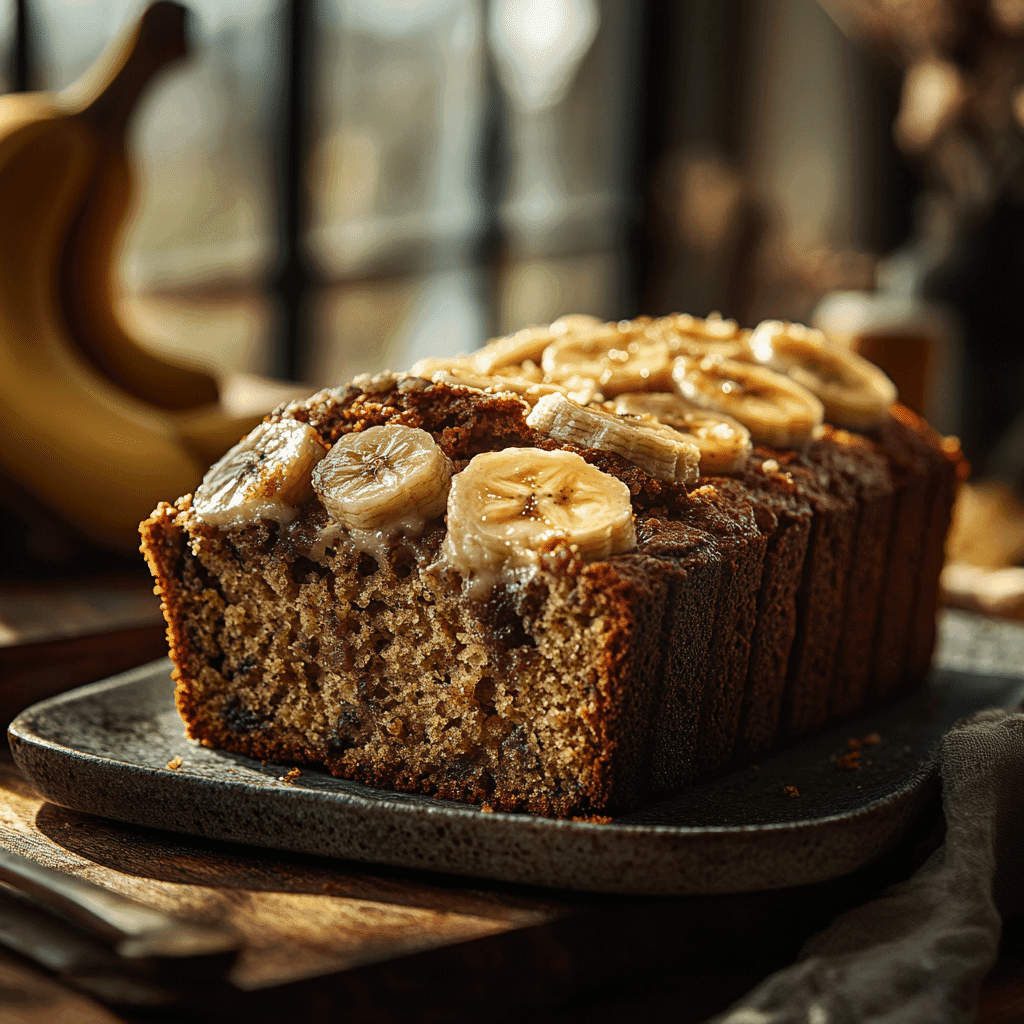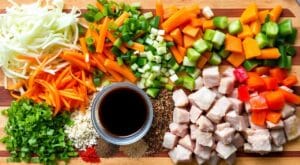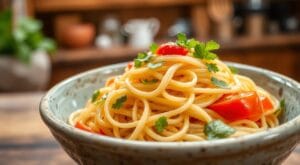Jump to:
Estimated reading time: 11 minutes
Table of contents
Introduction
Banana bread is a beloved treat, known for its moist texture and sweet, comforting flavor. However, sometimes you might find yourself in the middle of baking only to realize you’re out of baking soda. Don’t worry! There are several effective substitutes that can still help you achieve that perfect banana bread. In this article, we’ll explore various options for what is a substitute for baking soda in banana bread, explaining how each one works and how to use it effectively.
Why Choose Baking Soda Substitutes for Banana Bread?
Baking soda is a common leavening agent used in baking, known for its ability to make baked goods rise by producing carbon dioxide when mixed with an acid. However, there are several reasons you might need a substitute. Whether you’ve run out, are looking to avoid the slightly metallic aftertaste baking soda can sometimes impart, or prefer to use an alternative for dietary reasons, knowing what is a substitute for baking soda in banana bread can be a game changer. To better understand the differences between baking soda and baking powder, check out this detailed article from Bon Appétit.
Substituting baking soda doesn’t mean you have to compromise on the texture or flavor of your banana bread. The key is understanding how each substitute works. Some options may add a slight tang to your bread, while others might result in a denser loaf. However, with the right adjustments, your banana bread will still be deliciously moist and flavorful. By experimenting with these substitutes, you might even discover a new favorite variation of this classic recipe!

Ingredients Overview
What You’ll Need for Banana Bread Without Baking Soda
Here’s a list of common ingredients and the substitutes you can use in place of baking soda:
- All-Purpose Flour: 1 ½ cups
- Ripe Bananas: 3 medium-sized, mashed
- Granulated Sugar: ½ cup
- Brown Sugar: ½ cup, packed
- Eggs: 2 large
- Butter: ½ cup, melted (or oil for a lighter texture)
- Vanilla Extract: 1 teaspoon
- Salt: ¼ teaspoon
- Milk: ¼ cup (optional for a moister loaf)
Substitute for Baking Soda:
- Baking Powder: 3 teaspoons
- Self-Rising Flour: Replace the all-purpose flour and omit salt and baking soda
- Yeast: ½ teaspoon, dissolved in warm water
- Buttermilk: Use instead of regular milk and reduce other liquids slightly
- Club Soda: ½ cup, added at the end of mixing
- Baker’s Ammonia: 1 teaspoon (for a crisper texture)
If you’re looking for a direct recipe to try, check out this related post on Free Baking Soda Banana Bread Recipe for more detailed instructions.
Substitutions to Customize Banana Bread
Understanding what is a substitute for baking soda in banana bread can allow you to tailor the recipe to your specific needs or dietary preferences. Here are some substitutions:
- Baking Powder: This is the most straightforward substitute. Since it contains both an acid and a base, it eliminates the need for an additional acid in your recipe. Use 3 teaspoons of baking powder for every 1 teaspoon of baking soda.
- Self-Rising Flour: A pre-mixed combination of flour, baking powder, and salt. By replacing the all-purpose flour with self-rising flour, you can omit baking soda and salt altogether. This option is particularly convenient but may result in a slightly denser bread.
- Buttermilk: This acidic liquid can help leaven your banana bread when paired with a small amount of baking powder. If using buttermilk, reduce the other liquids in your recipe by about ¼ cup. For more on the benefits of using yogurt, which can also be a great substitute, see this Healthline article on the benefits of Greek yogurt.
- Yeast: Though not a common substitute for baking soda, yeast can be used in a pinch. Dissolve ½ teaspoon of yeast in warm water and mix it into your batter. The result will be a denser, slightly tangy loaf, somewhat like a sweet bread.
- Club Soda: This fizzy water can act as a leavening agent, though it’s not as potent as baking soda. Substitute ½ cup of club soda for other liquids at the end of your mixing process. This can help give your banana bread a lighter texture.
- Baker’s Ammonia: Also known as ammonium carbonate, this old-fashioned leavening agent was used before baking powder became widely available. It produces carbon dioxide and ammonia gas, which evaporates during baking, leaving no trace of flavor. It’s best used in smaller amounts, about 1 teaspoon, and is more suitable for crisp textures.
Step-by-Step Preparation:
- Preheat Your Oven: Set your oven to 350°F (175°C). Grease a 9×5 inch loaf pan or line it with parchment paper for easier removal.
- Prepare the Dry Ingredients: In a large mixing bowl, combine 1 ½ cups of all-purpose flour, 3 teaspoons of your chosen substitute (e.g., baking powder), and ¼ teaspoon of salt. Whisk these ingredients together until well blended.
- Mash the Bananas: In a separate bowl, mash 3 ripe bananas until smooth. A few lumps are fine as they add texture to the bread.
- Mix the Wet Ingredients: To the mashed bananas, add ½ cup of granulated sugar, ½ cup of packed brown sugar, 2 large eggs, 1 teaspoon of vanilla extract, and ½ cup of melted butter. Stir until the mixture is well combined. If using buttermilk or club soda as your substitute, add it at this stage.
- Combine Wet and Dry Ingredients: Pour the wet ingredients into the dry ingredients. Gently fold them together until just combined. Avoid overmixing, as this can make your bread tough.
- Add the Optional Ingredients: If you prefer a moister loaf, add ¼ cup of milk at this stage. Mix until just incorporated. This step is optional, but it can help create a softer texture, especially if using a denser substitute like self-rising flour.
- Pour into the Loaf Pan: Transfer the batter into your prepared loaf pan, spreading it evenly with a spatula.
- Bake: Place the loaf pan in the preheated oven. Bake for 60 to 70 minutes, or until a toothpick inserted into the center comes out clean. If using yeast, the baking time might be slightly longer, so keep an eye on your bread.
- Cool and Serve: Allow the banana bread to cool in the pan for about 10 minutes before transferring it to a wire rack to cool completely. Slice and enjoy!
For more tips on properly storing banana bread, consider reading this guide from AllRecipes.
Enhancing Banana Bread Without Baking Soda
Experimenting with different substitutes for baking soda can lead to exciting variations of banana bread. Here are additional tips and variations to explore:
- Adding Yogurt: Incorporating yogurt can add a tangy flavor and increase moisture. If using yogurt, consider reducing other liquids slightly to maintain the right consistency in your batter. Greek yogurt, in particular, adds a rich, creamy texture and boosts the protein content of your bread.
- Incorporating Different Sweeteners: Swap out white sugar for alternatives like coconut sugar, honey, or maple syrup. These natural sweeteners add unique flavors and reduce the glycemic index, making your banana bread a bit healthier. For example, maple syrup lends a deep, caramel-like flavor that pairs beautifully with bananas.
- Playing with Flour Types: While all-purpose flour is standard, you can experiment with almond flour, oat flour, or a gluten-free blend. Almond flour adds a slightly nutty flavor and a denser texture, while oat flour can make your bread more tender and add a subtle, wholesome flavor. Gluten-free flour is ideal for those with dietary restrictions, and the texture can be surprisingly similar to traditional banana bread when paired with the right leavening agents.
- Infusing with Spices and Extracts: Beyond the usual cinnamon, try adding cardamom, ginger, or even a pinch of cloves for a warm, aromatic twist. Additionally, almond extract or a splash of rum can add depth and complexity to your banana bread.
- Adding a Crunch: To enhance the texture, consider sprinkling crushed nuts like walnuts, pecans, or almonds on top of the batter before baking. This not only adds a satisfying crunch but also gives your bread an attractive, bakery-style finish.
These enhancements are great ways to personalize your banana bread, ensuring it remains a favorite in your household even without traditional baking soda.
How to Store Banana Bread Without Baking Soda
Proper storage ensures that your banana bread stays fresh and delicious for as long as possible. Here are some additional tips:
- Freezing in Portions: If you don’t plan to eat the entire loaf at once, consider slicing the bread before freezing. Place slices in a single layer on a baking sheet to freeze individually, then transfer them to a freezer-safe bag. This way, you can easily thaw one slice at a time without having to defrost the entire loaf.
- Vacuum Sealing for Longevity: For longer-term storage, use a vacuum sealer to remove air from the packaging before freezing. This method can extend the bread’s freezer life and prevent freezer burn, ensuring the texture and flavor are preserved.
- Reheating Tips: To revive frozen or refrigerated banana bread, consider reheating slices in the oven at 300°F (150°C) for 10 minutes. This will bring back the bread’s freshness, making it taste like it’s just been baked. If you prefer a softer texture, microwaving for 20-30 seconds can also do the trick.
Storing your banana bread properly will allow you to enjoy it over several days or weeks without sacrificing quality.

Nutritional Benefits of Banana Bread Without Baking Soda
When substituting baking soda, the nutritional profile of your banana bread can be slightly altered. Here’s a deeper look into how different substitutes can affect your banana bread’s health benefits:
- Using Greek Yogurt: Substituting some of the butter or oil with Greek yogurt not only reduces fat content but also increases the protein level. Greek yogurt is rich in probiotics, which can aid digestion and contribute to a healthy gut. Learn more about the benefits of Greek yogurt here.
- Incorporating Oats or Almond Flour: Adding oats or almond flour instead of some all-purpose flour can significantly boost the fiber and healthy fat content of your banana bread. Oats are also a good source of beta-glucan, a type of soluble fiber that can help lower cholesterol levels.
- Reducing Sugar: Replacing refined sugar with honey, maple syrup, or coconut sugar can lower the overall glycemic index of your bread, making it a better option for those monitoring their blood sugar levels. These natural sweeteners also add beneficial minerals and antioxidants that refined sugar lacks.
- Including Nuts: Adding walnuts, almonds, or pecans to your banana bread introduces healthy fats, protein, and essential nutrients like magnesium and vitamin E. Nuts are known for their heart-healthy properties and can add both flavor and nutrition to your bread.
Understanding the nutritional impact of your ingredients allows you to make healthier choices without compromising on the taste or texture of your banana bread.
FAQ About Banana Bread Without Baking Soda
Can I use cream of tartar as a substitute for baking soda?
Cream of tartar can be used in combination with baking powder as a substitute for baking soda. Cream of tartar is an acid that, when combined with baking powder, can provide the necessary leavening action. Use about ½ teaspoon of cream of tartar for every teaspoon of baking powder, and adjust other ingredients accordingly.
What can I do if my banana bread turns out too dense?
If your banana bread ends up too dense, it might be due to overmixing or not enough leavening. To avoid this, mix the batter just until the ingredients are combined, and ensure that your leavening agents (like baking powder or yeast) are fresh. Adding a bit more liquid, such as milk or yogurt, can also help lighten the texture.
Is there a vegan substitute for baking soda in banana bread?
Yes, there are several vegan-friendly substitutes for baking soda. Baking powder is a great option, as it does not contain any animal products. You can also use a combination of apple cider vinegar and baking powder to help with leavening. For a vegan recipe, make sure all other ingredients, like butter and eggs, are replaced with plant-based alternatives like coconut oil and flax eggs.
Can I make banana bread without any leavening agents?
It’s possible, but the texture will be much denser and more cake-like. If you’re avoiding all leavening agents, consider making a banana loaf that focuses on the moist, rich flavor of bananas. Adding ingredients like extra mashed bananas, applesauce, or even finely grated zucchini can enhance the moisture content and make the bread more palatable without leavening.
Conclusion: Mastering Banana Bread Without Baking Soda
In the world of baking, flexibility and creativity are key. Understanding what is a substitute for baking soda in banana bread not only helps you rescue a recipe when you’re out of baking soda but also allows you to experiment with new flavors and textures. Whether you choose baking powder, self-rising flour, or a more unconventional substitute like yeast, the most important thing is to maintain the balance of ingredients to achieve that beloved moist, tender banana bread.
By exploring different substitutes, you might discover a version of banana bread that you love even more than the traditional one. Baking is as much about the process as it is about the outcome, so don’t hesitate to try new methods and ingredients. With the tips and variations provided in this article, you’ll be well-equipped to make delicious banana bread, even without baking soda. Happy baking!







1 thought on “What Is a Substitute for Baking Soda in Banana Bread? Try These Proven Baking Hacks”